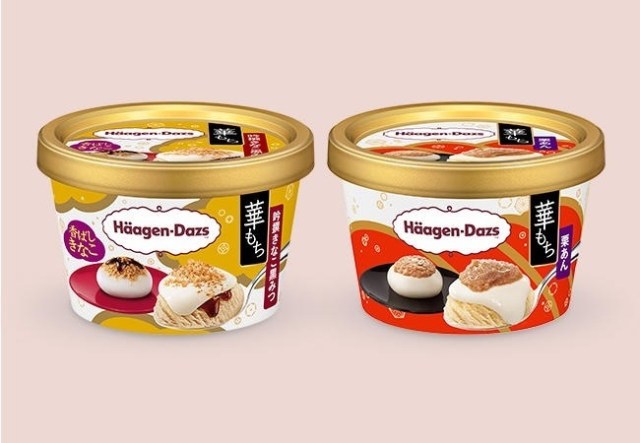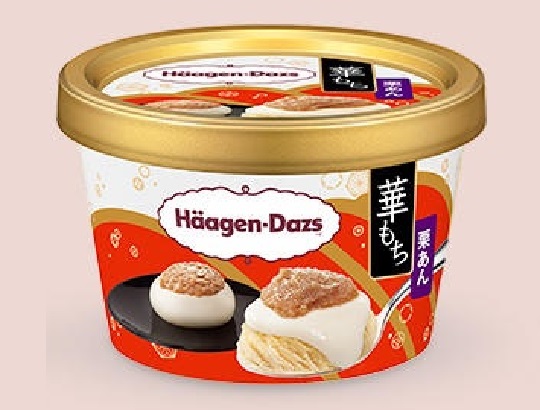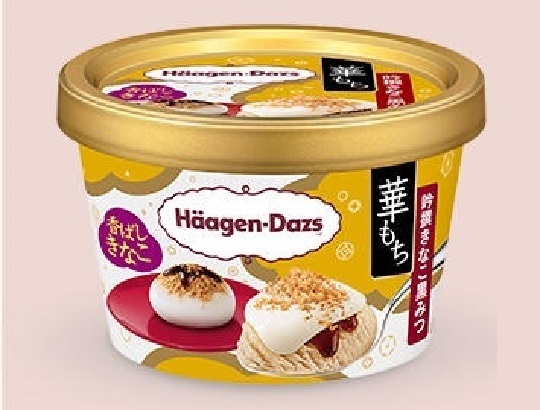
Ice cream maker rolls out two mochi-enhanced flavors we’re happy to dig into even after the weather gets cooler.
It’s natural to feel a twinge of sadness at the end of summer, as we transition from fun in the sun to longer, colder nights. Of course, the best way to shake off bittersweet feelings is with sweet desserts, and to that end Häagen-Dazs Japan is ready and willing to help.
Japanese foodies always appreciate it when seasonal ingredients are incorporated into a dish, and that goes for sweets too. So this month Häagen-Dazs is rolling out a brand-new flavor: chestnut sweet bean mochi.
If you’re going by the Japanese name, it’s the Hanamochi Kuri An, kuri being the Japanese word for “chestnuts,” which will be coming into season shortly as we get further into autumn. While most people think of the red version of anko (traditional Japanese sweet bean paste), Häagen-Dazs chestnut sweet bean mochi uses white anko, which has a slightly richer, less intensely sweet taste. Joining the white anko ice cream is chestnut sauce with a subtle hint of salt, added to help draw out more of the nut’s latent sweetness. And since this is part of the Hanamochi line, sitting atop the ice cream is a layer of chestnut anko mochi, lightly dusted with sugar, giving you all sorts of textures and flavors to enjoy.
Also set to grace supermarket and convenience store freezer cases is the Hanamochi Ginse Kinako Kuromitsu.
This isn’t an all-new flavor, as it’s been offered for limited times on multiple occasions in the past. Those encore appearances are proof, though, of how well kinako (roasted soybean powder, here made with a mix of yellow and black beans for a richer flavor and fragrance) works as an ice cream enhancer, especially when it’s backed up with kuromitsu, an old-school Japanese brown sugar syrup, and a mochi topping. Plus, since Häagen-Dazs likes to tinker with the exact ratio of ingredients, this year’s Ginse Kinako Kuromitsu might offer a slightly different experience than the one from years past.
Both flavors go on sale September 29, priced at 295 yen (US$2.75), and are excellent options for capping off a meal of other foods Japan loves to eat in the fall.
Source: Häagen-Dazs via Entabe
Images: Häagen-Dazs
● Want to hear about SoraNews24’s latest articles as soon as they’re published? Follow us on Facebook and Twitter!



 Häagen-Dazs’ awesome mochi ice creams with black sugar syrup and sweet miso glaze are coming back
Häagen-Dazs’ awesome mochi ice creams with black sugar syrup and sweet miso glaze are coming back Häagen-Dazs Japan comes out with sticky-sweet new line of ice cream containing … mochi!
Häagen-Dazs Japan comes out with sticky-sweet new line of ice cream containing … mochi! Häagen-Dazs new Japanese ice cream looks freaky, tastes great
Häagen-Dazs new Japanese ice cream looks freaky, tastes great Häagen-Dazs releases new mochi ice cream, and it’s amazing! 【Taste test】
Häagen-Dazs releases new mochi ice cream, and it’s amazing! 【Taste test】 Häagen-Dazs new zunda mochi ice cream gives us a lot of delicious things to think about
Häagen-Dazs new zunda mochi ice cream gives us a lot of delicious things to think about Foreigner’s request for help in Tokyo makes us sad for the state of society
Foreigner’s request for help in Tokyo makes us sad for the state of society Japanese city loses residents’ personal data, which was on paper being transported on a windy day
Japanese city loses residents’ personal data, which was on paper being transported on a windy day Historical figures get manga makeovers from artists of Spy x Family, My Hero Academia and more
Historical figures get manga makeovers from artists of Spy x Family, My Hero Academia and more Harajuku Station’s beautiful old wooden building is set to return, with a new complex around it
Harajuku Station’s beautiful old wooden building is set to return, with a new complex around it Akihabara pop-up shop sells goods made by Japanese prison inmates
Akihabara pop-up shop sells goods made by Japanese prison inmates Sandwiches fit for a sumo served up in Osaka【Taste Test】
Sandwiches fit for a sumo served up in Osaka【Taste Test】 Anime girl English teacher Ellen-sensei becomes VTuber/VVTUber and NFT
Anime girl English teacher Ellen-sensei becomes VTuber/VVTUber and NFT Ghibli Park now selling “Grilled Frogs” from food cart in Valley of Witches
Ghibli Park now selling “Grilled Frogs” from food cart in Valley of Witches Daiso opens massive new 25,392-square foot Tokyo flagship store with its two sub-brands included
Daiso opens massive new 25,392-square foot Tokyo flagship store with its two sub-brands included We try out “Chan Ramen”, an underground type of ramen popular in the ramen community
We try out “Chan Ramen”, an underground type of ramen popular in the ramen community McDonald’s new Happy Meals offer up cute and practical Sanrio lifestyle goods
McDonald’s new Happy Meals offer up cute and practical Sanrio lifestyle goods Japanese ramen restaurants under pressure from new yen banknotes
Japanese ramen restaurants under pressure from new yen banknotes French Fries Bread in Tokyo’s Shibuya becomes a hit on social media
French Fries Bread in Tokyo’s Shibuya becomes a hit on social media Studio Ghibli releases new action figures featuring Nausicaä of the Valley of the Wind characters
Studio Ghibli releases new action figures featuring Nausicaä of the Valley of the Wind characters New private rooms on Tokaido Shinkansen change the way we travel from Tokyo to Kyoto
New private rooms on Tokaido Shinkansen change the way we travel from Tokyo to Kyoto Red light district sushi restaurant in Tokyo shows us just how wrong we were about it
Red light district sushi restaurant in Tokyo shows us just how wrong we were about it Tokyo Tsukiji fish market site to be redeveloped with 50,000-seat stadium, hotel, shopping center
Tokyo Tsukiji fish market site to be redeveloped with 50,000-seat stadium, hotel, shopping center All-you-can-drink Starbucks and amazing views part of Tokyo’s new 170 meter-high sky lounge
All-you-can-drink Starbucks and amazing views part of Tokyo’s new 170 meter-high sky lounge Beautiful Ghibli sealing wax kits let you create accessories and elegant letter decorations【Pics】
Beautiful Ghibli sealing wax kits let you create accessories and elegant letter decorations【Pics】 Studio Ghibli releases Kiki’s Delivery Service chocolate cake pouches in Japan
Studio Ghibli releases Kiki’s Delivery Service chocolate cake pouches in Japan New definition of “Japanese whiskey” goes into effect to prevent fakes from fooling overseas buyers
New definition of “Japanese whiskey” goes into effect to prevent fakes from fooling overseas buyers Our Japanese reporter visits Costco in the U.S., finds super American and very Japanese things
Our Japanese reporter visits Costco in the U.S., finds super American and very Japanese things Studio Ghibli unveils Mother’s Day gift set that captures the love in My Neighbour Totoro
Studio Ghibli unveils Mother’s Day gift set that captures the love in My Neighbour Totoro More foreign tourists than ever before in history visited Japan last month
More foreign tourists than ever before in history visited Japan last month New Pokémon cakes let you eat your way through Pikachu and all the Eevee evolutions
New Pokémon cakes let you eat your way through Pikachu and all the Eevee evolutions Sales of Japan’s most convenient train ticket/shopping payment cards suspended indefinitely
Sales of Japan’s most convenient train ticket/shopping payment cards suspended indefinitely Sold-out Studio Ghibli desktop humidifiers are back so Totoro can help you through the dry season
Sold-out Studio Ghibli desktop humidifiers are back so Totoro can help you through the dry season Japanese government to make first change to romanization spelling rules since the 1950s
Japanese government to make first change to romanization spelling rules since the 1950s Ghibli founders Toshio Suzuki and Hayao Miyazaki contribute to Japanese whisky Totoro label design
Ghibli founders Toshio Suzuki and Hayao Miyazaki contribute to Japanese whisky Totoro label design Doraemon found buried at sea as scene from 1993 anime becomes real life【Photos】
Doraemon found buried at sea as scene from 1993 anime becomes real life【Photos】 Tokyo’s most famous Starbucks is closed
Tokyo’s most famous Starbucks is closed One Piece characters’ nationalities revealed, but fans have mixed opinions
One Piece characters’ nationalities revealed, but fans have mixed opinions We asked a Uniqlo employee what four things we should buy and their suggestions didn’t disappoint
We asked a Uniqlo employee what four things we should buy and their suggestions didn’t disappoint Princesses, fruits, and blacksmiths: Study reveals the 30 most unusual family names in Japan
Princesses, fruits, and blacksmiths: Study reveals the 30 most unusual family names in Japan Häagen-Dazs’ triple cherry blossom mochi ice cream promises Japan an early taste of spring
Häagen-Dazs’ triple cherry blossom mochi ice cream promises Japan an early taste of spring Häagen-Dazs Japan’s delicious mochi ice cream makes a comeback this fall
Häagen-Dazs Japan’s delicious mochi ice cream makes a comeback this fall Häagen-Dazs tempts us with first-ever Japanese flavor sorbet and ice cream combo!
Häagen-Dazs tempts us with first-ever Japanese flavor sorbet and ice cream combo! Häagen-Dazs’ Matcha Azuki Kuromitsu Japonais ice cream blends green tea, red bean, black syrup
Häagen-Dazs’ Matcha Azuki Kuromitsu Japonais ice cream blends green tea, red bean, black syrup Häagen-Dazs Japan’s new green tea honey toast dessert has us ready to sing with joy
Häagen-Dazs Japan’s new green tea honey toast dessert has us ready to sing with joy Häagen-Dazs awesome hojicha latte is a whole new way to love Japanese tea ice cream
Häagen-Dazs awesome hojicha latte is a whole new way to love Japanese tea ice cream Häagen-Dazs Japan’s Yuzu Green Tea Float — How to make the super-easy matcha summer dessert drink
Häagen-Dazs Japan’s Yuzu Green Tea Float — How to make the super-easy matcha summer dessert drink Häagen-Dazs Japan announces azuki bean ice cream, net users go wild
Häagen-Dazs Japan announces azuki bean ice cream, net users go wild Häagen-Dazs’ Japan’s new sweet potato ice cream disappoints AND completely satisfies us
Häagen-Dazs’ Japan’s new sweet potato ice cream disappoints AND completely satisfies us Häagen-Dazs’ upcoming traditional Japanese sweets cafe in Tokyo has our mouths watering already
Häagen-Dazs’ upcoming traditional Japanese sweets cafe in Tokyo has our mouths watering already Häagen-Dazs Bakery opens in Tokyo, and its baked goods are so good
Häagen-Dazs Bakery opens in Tokyo, and its baked goods are so good Häagen-Dazs opens limited time traditional Japanese-style-sweets dessert cafe【Pics】
Häagen-Dazs opens limited time traditional Japanese-style-sweets dessert cafe【Pics】 “Glossy green tea donuts” sound weird, look amazing in Mr. Donut team-up with Kyoto matcha master
“Glossy green tea donuts” sound weird, look amazing in Mr. Donut team-up with Kyoto matcha master Red bean paste and cream cheese — a divinely sweet combination?
Red bean paste and cream cheese — a divinely sweet combination? Ikea Japan wants to furnish your stomach with matcha sweets with its new cafe dessert menu【Pics】
Ikea Japan wants to furnish your stomach with matcha sweets with its new cafe dessert menu【Pics】 Häagen-Dazs’ new gold matcha ice cream has French heritage and our full attention
Häagen-Dazs’ new gold matcha ice cream has French heritage and our full attention
Leave a Reply